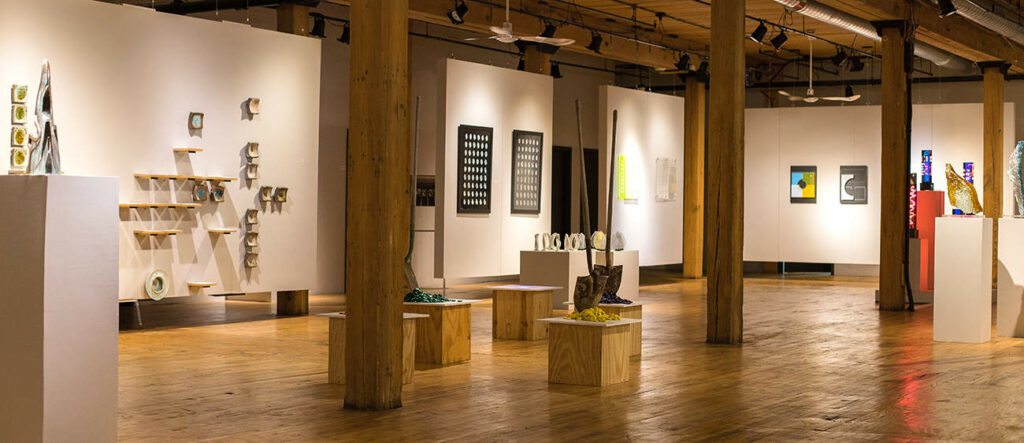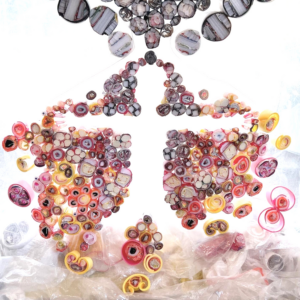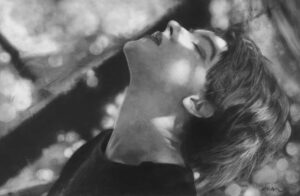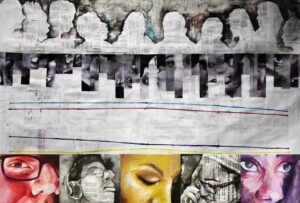Three-Dimensional presents work in a wide range of materials and approaches, from modernist abstraction to conceptual mixed media installation. As an overview of contemporary sculpture, the show can be a valuable experience, especially for students.
Marshall Svendsen’s cast bronze works relate to the tradition of sculpture associated with one of Modernism’s greats, Henry Moore, as well as Bridgeport’s own world-renowned sculptor Virginio Ferrari. The works are a blending of organic and geometric elements. Like the original Modernists, Svendsen’s pieces derive inspiration from ancient art, not only in using the traditional medium of cast bronze, but also in an attitude toward the unconscious. Works in the Bridgeport show are part of Svendsen’s “primitive series”, in which he claims to develop and visually formulate his unconscious thinking into each finished piece.
Donna Hapac’s sculptures are well-known in the Chicago region as works that utilize an unusual sculpting material – malleable and natural reed and waxed linen – to create what she calls “drawings in space”. Recently, the artist has also been exploring the medium of constructions in wood. Her sculptures evoke the natural forms of animals and plants to “inspire an appreciation for the beauty to be discovered and preserved in our natural environment”.
She writes:
“I identify with Post-Minimal artists, in my use of simple or unconventional materials and processes, combined with a formalist aesthetic. The approach is experimental and intuitive, following the materials and responding to possibilities as they arise.”
In one respect, Svendsen’s cast bronze and Hapac’s woven reed can be seen as opposite ends of a spectrum – one emphasizes physical strength and a kind of maleness while the other references a largely female tradition of weaving. Both present powerful and beautiful works.
During some three decades at Illinois Institute of Technology, as a professor and gallery director, Robert Krawczyk developed and taught a series of computer-aided design and digital design courses covering 2D and 3D CAD, image composition, animation, and form generation methods. The artist, who participated in the BAC exhibition of art by architects a few months ago, returns with a collection of small pieces designed digitally and laser-cut. The little sculptures are accompanied on the adjacent wall by two large drawings of all the pieces. The titles have no natural references but seem to be formulas relating to the manufacture of each piece (Being Dis-Functional: 01_01f1d, for example). Although this kind of sculpture can be seen as somewhat cold and intellectual, in its seeming absence of a human touch, yet viewers can appreciate the forms according to their own personal experiences and aesthetic imagination.

Another artist utilizing cutting edge methods is Yvette Kaiser Smith, who presents five bas-reliefs in laser-cut and engraved acrylic. These meticulous works are layered to create a beautiful interaction of color and shape. Purely abstract and geometric in design, they are nevertheless lyrical in feeling. Says Yvette: “Sequences from transcendental numbers pi and e, prime numbers, grids, and repetition of simple geometric shapes are my obsession. I devise systems for visualizing numerical values by which I can create new and uncommon patterns where the grid serves as an armature for plotting sequences, and grid and sequences serve as armatures for exploring patterns.”
Lollie Bennish also works in cut acrylic, creating towers containing curving neon light tubes that illuminate the surrounding colored acrylic panels. In this show, they are displayed as a group of four pieces of differing heights, creating a larger sculptural work. The artist is interested in neon, particularly the way the light reflects on other materials such as aluminum and glass.
“I discovered that combining neon with fiberglass is an especially powerful way to bring out the charm and vibrancy of the lights, which dance, play and move throughout the sculptures with elegance and energy.”
John Denis displays three of his crushed glass and acrylic sculptures. His work, says the artist, is a reflection of his time spent on the Pacific Coast: “The relevance and infinite character of the ocean has always fueled my senses and imagination.” John recently moved into one of the galleries that are part of “Gallery Row” on the first floor of the Bridgeport Art Center, and a larger number of his works may be viewed there in addition to the pieces that are currently in the gallery.
I have left the work of Jay Strommen for last, because his contribution to this show is so large, complex and varied, ranging from beautiful glazed clay wall panels to some very conceptual works. Jay is an internationally renowned ceramic artist who is also the founder and developer of the Chicago Ceramic Center on the 5th floor of the Bridgeport Art Center. Jay’s work also may be found all over the building, in a variety of decorative embellishments in hallways and other public spaces. Until recently he was represented by Perimeter Gallery (now closed) and one of the most interesting contributions to this exhibit is a group of shovels standing in mounds of painted “tokens of appreciation” and dedicated to Frank (Paluch) of Perimeter.
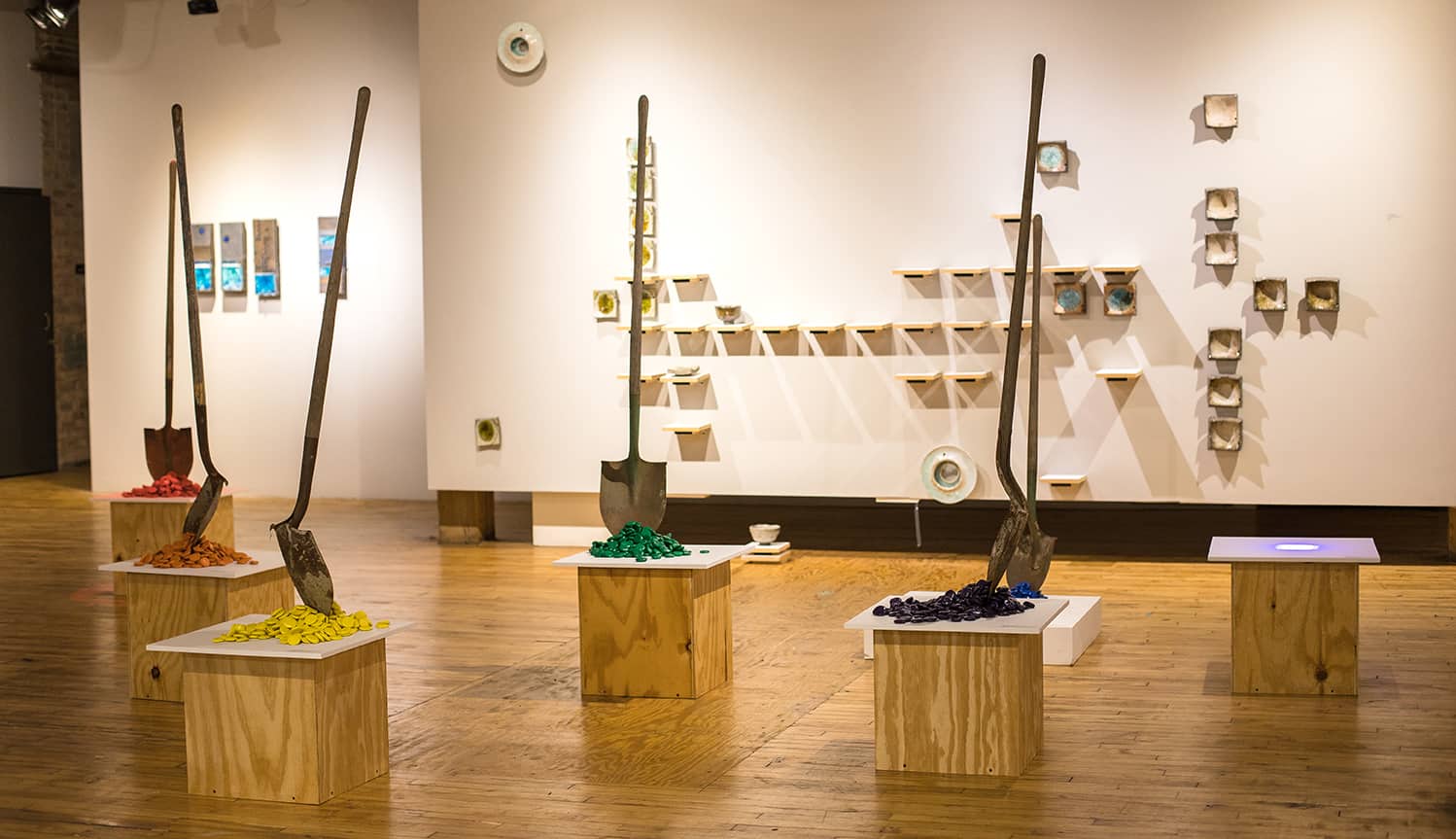
“Tokens of Appreciation provide positive energy to any surroundings or situation. The gesture of giving and taking combined, equals sharing. As a contemporary artist serving the ancient traditions, ceremony and the preservation of the imagination are of the utmost importance. I feel honored to have arrived at a point in my artistic discoveries that fully engage the current preconceptions of what “art” really is, furthermore, creating works of art that all humanity can enjoy sharing.”
In 2000, Jay received his M.F.A. from The School of the Art Institute of Chicago, as a student of Bill Farrell. From 1993-1996, he apprenticed with David and Barbara Hoggatt at the Sanibel Pottery of Sanibel Island Florida. He has also taken many workshops around the world. From November 1, 2001 through April 2002, he was honored as an artist in residence at the Shigaraki Ceramic Cultural Park, Shiga Prefecture, Japan. Strommen’s work and philosophy are inspiring and I encourage everyone to read more about Jay online.
To learn more about Jay Strommen: http://thehardscrabbler.blogspot.com/2017/12/art-potter.html
Lelde Kalmite, Curator
